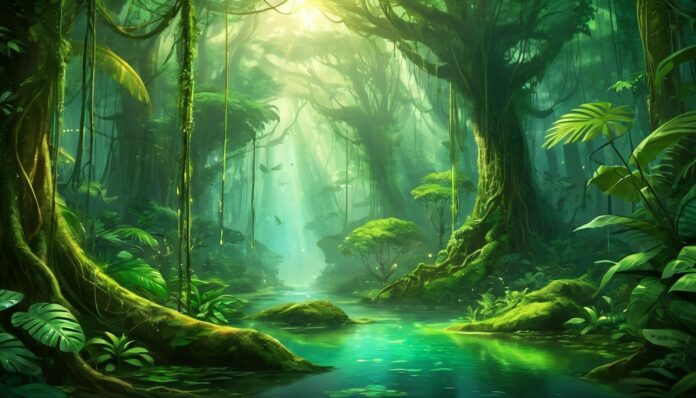The Amazon Rainforest is one of the most incredible and vital ecosystems on our planet. Covering a large portion of South America, it is often referred to as the “lungs of the Earth” due to its crucial role in producing oxygen and regulating the global climate.
Location and Size
The Amazon Rainforest spans across nine countries: Brazil, Peru, Colombia, Venezuela, Ecuador, Bolivia, Guyana, Suriname, and French Guiana. It covers approximately 5.5 million square kilometers (2.1 million square miles), making it the largest tropical rainforest in the world.
Biodiversity
The Amazon Rainforest is home to an astounding variety of life. It hosts around 390 billion individual trees divided into 16,000 species. The rainforest also provides habitat for over 2.5 million insect species, tens of thousands of plants, and about 2,000 birds and mammals.
Unique Plants
The Amazon is known for its diverse plant life, including towering trees like the Brazil nut tree and the kapok tree. It is also home to numerous medicinal plants, many of which are used in traditional and modern medicine. The rainforest’s flora plays a critical role in maintaining the Earth’s climate and weather patterns.
Diverse Wildlife
The wildlife of the Amazon Rainforest is incredibly diverse. Iconic animals include jaguars, sloths, river dolphins, and macaws. The rainforest is also home to various species of monkeys, frogs, and butterflies. The Amazon River, which flows through the rainforest, is teeming with life, including piranhas, anacondas, and the massive Arapaima fish.
Indigenous Peoples
The Amazon Rainforest is home to around 400 indigenous tribes, each with its own distinct culture and language. These communities rely on the forest for food, shelter, and medicine. They have a deep understanding of the rainforest’s ecosystems and play a vital role in its conservation.
Climate and Rainfall
The Amazon Rainforest experiences a tropical climate with high temperatures and humidity. It receives an average annual rainfall of about 2,000 to 3,000 millimeters (80 to 120 inches). This consistent rainfall supports the lush, dense vegetation and diverse wildlife of the region.
Importance to the Planet
The Amazon Rainforest plays a crucial role in the Earth’s carbon cycle. It absorbs large amounts of carbon dioxide, helping to mitigate climate change. The rainforest also produces about 20% of the world’s oxygen, which is essential for all living beings.
Threats to the Amazon
Despite its importance, the Amazon Rainforest faces significant threats. Deforestation, primarily due to agriculture, logging, and mining, is a major concern. Habitat destruction leads to the loss of biodiversity and contributes to climate change. Efforts are being made to protect and conserve this vital ecosystem.
Interesting Facts About the Amazon Rainforest
- The Amazon River, the second-longest river in the world, flows through the rainforest.
- The Amazon Rainforest produces about 20% of the world’s oxygen.
- It is home to around 400 billion trees.
- The rainforest contains more than 2,500 tree species.
- It houses over 10% of the world’s known species.
- The Amazon basin covers approximately 40% of the South American continent.
- The rainforest is estimated to be around 55 million years old.
- It is home to the world’s largest variety of birds.
- The Amazon’s forest floor is often dark due to the dense canopy above.
- Many plants in the Amazon have not yet been studied by scientists.
- The Amazon River discharges more water than the next seven largest rivers combined.
- Some parts of the Amazon receive up to 9 feet of rain annually.
- The rainforest acts as a massive carbon sink, absorbing CO2 from the atmosphere.
- Indigenous tribes in the Amazon have lived there for thousands of years.
- The Amazon has a vast network of rivers and streams, known as the “River Sea.”
- It is home to the pink river dolphin, one of the few freshwater dolphin species.
- The rainforest has its own unique seasons, influenced by the rain patterns.
- The Amazon harbors many undiscovered species of plants and animals.
- Some areas of the Amazon are still unexplored and unmapped.
- The rainforest contributes to the water cycle, impacting global weather patterns.
- It is home to the world’s largest rodent, the capybara.
- The Amazon is crucial for the survival of many endangered species.
- The forest floor is rich in nutrients, supporting diverse plant life.
- The Amazon’s biodiversity is essential for medical research.
- The rainforest helps in stabilizing the global climate.
- It supports the livelihoods of millions of people.
- The Amazon has unique ecosystems, such as flooded forests and savannas.
- It plays a key role in the cultural heritage of South America.
- The Amazon’s canopy is a habitat for many tree-dwelling species.
- Conservation efforts are vital to preserving this irreplaceable ecosystem.
The Amazon Rainforest is a treasure trove of biodiversity and an essential part of the Earth’s ecological balance. Protecting this magnificent ecosystem is crucial for the health of our planet and future generations.
